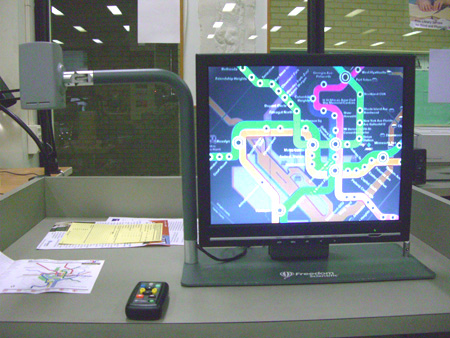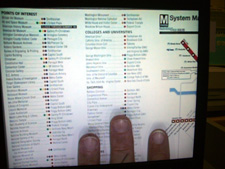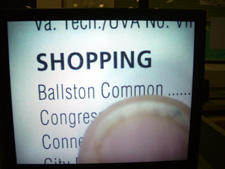The following is a gathering of my thought for putting on an Accessibility Camp (BarCamp style event) here in Washington, DC last fall. Some of the items listed here were due to the fact that we had individuals that were either blind or visually impaired, deaf or hard of hearing, or had some other disability.
Accessible copies of these notes in both Microsoft WORD and PDF formats will be at bottom of this blog post. (<b>** UPDATED – 2010/09/12 **</b>)
The most important part after getting a few good helpers is to get yourself a location, location, location that is accessible to all first before worrying about a date. One of the hardest parts of putting on Accessibility Camp DC was finding a free location near the bus and the metro (subway).
I spent from about the beginning of May until the middle of August looking for a place to have the event. Then it was a few weeks to get all the approvals from the Martin Luther King Jr. library to have the event there. The library normally doesn’t allow people to have more than one room let alone a few for an entire day, it’s normally just a few hours. Luckily I had had someone that worked there and in the Adaptive Technology Center where part of the event took place.
They have a great deal of assistive technology for all the patrons that use the equipment on a daily basis. By having it a the library we had a whole other level of complexity, since they were sending notes out to all the people that attend their other monthly events. By doing so we needed to have CART (Communication Access Real-Time Translation) which is a device for people that are hard of hearing, Sign Language Interpreters (SLI), and the like.
The next thing to make sure you have at your location is some of the following that have to do with the facilities.
Facility requirements
- screens and projectors
- wifi
- Ethernet connections for speakers at least
- mirco-phones for speakers and ones to pass for questions (optional)
- CART – “Communication Access Real-Time Translation”
- Sign Language Interpreters (SLI)
Next thing to worry about is enough sponsors for the event. The more money you have the more people that can attend. We allowed a maximum donation of $250 so large companies could have try and have a say over the event. We also had a minimum amount of $50, so you did not lose a good chunk of your money to Paypal fees etc. We have found that some of the people/companies that gave the least expected the most from us. One even complained that they were not on the website list only a few hours after giving us the money. They forget that some of us have day jobs and can’t just get on the server from the office to update things.
If you have an over abundance of money you could get t-shirts with the events logo, date, location on front and list of sponsors on the back in alphabetical order so there are no issues. Also please don’t forget to put the people’s whose venue you are using on this list like we forgot last year for BarCamp DC.
You should create yourself a twitter account, purchase a domain, and figure out a short hashtag. We ended up using #AccessDC or was it #AccessCampDC, since #ACDC reminded meet to much of the band and would make it harder to search for on twitter search.
The next big item to start thinking about is food. We provided a small breakfast type stuff that we could use later in the day for snacks as well.
Breakfast
- bagels
- coffee
- juice
- OJ
- doughnuts
- breakfast bars
Lunch
- pizza or sandwiches
- chips
- cookies
- fruit (banana’s, apples, grapes, etc.)
Snacks
- candy (chocolate seems to work best)
- leftover breakfast bars
- chips and the like
- leftover fruit
Drinks
- juice
- coffee
- soda
- bottled water
- coffee creamer or half and half
Miscellaneous Items
- paper plates
- napkins
- silverware
- cups
- butter
- jam
- cream cheese
Create a nice accessible website, which we can link to from www.AccessibilityCamp.org once up I get it back up. We just used www.AccessibilityCampDC.org and placed a lot of information there. We had date, location, registration link, sponsors list on the home page at the bottom with links to their websites, a sponsors page, resources page for slides, links, etc. that came out of event.
Don’t forget to create an empty Google Excel type document the night before with talk times, room name or number, if it has a projector, and the like. This saves time and also allows you to create a www.bit.ly URL that will give us statistics on when and where people click on the link.
While still at the event we asked people if they would like to attend a monthly accessibility meeting to keep what you started going. People really wanted to keep it going so we just had our third monthly meeting and have speakers booked for the next two or three months already.
Registration
You will need to find a place/website to take registration for attendees and money from sponsors. We used www.eventbrite.com, which is not completely accessible (issues with e-mails for those using screen readers and other assistive technology), but allowed sponsors to pay with credit cards and put money in your or someone’s Paypal account. We have found it easier to get sponsors money once you have a firm date and location.
Do to the issues with attendee registration, sponsor money, and just admin for the worker’s, I have started wire-framing and gathering information to make my own conference registration web application. Hope to have it ready for our next big event sometime in the fall.
We started our registration with tickets for only a third or a quarter of the total number of people our location could hold. We notified people by twitter and word of month of the date event tickets would go on sale, this way people don’t grab tickets a month or two in advance and never show. We started with having 50 tickets available and said we were pacing them out over a few weeks up until 150 tickets as long as we got enough money. Plus, we wanted to make sure we had enough money to feed everyone. The following weeks we would let like 25 or 50 more tickets go at a time.
Make sure to ask the attendees at registration if people will need assistance (for individuals that are blind, need CART, SLI, Braille version of schedule, etc). We also asked for t-shirt sizes just in case we got them, this way we would not have all the wrong sizes and it would make ordering easier. We also stated that we might have them if enough money was not collected in time or at all, which is what happened with the slow economy.
Make sure the week before to send a note reminding people of the event etc. plus listing the sponsors. We also asked them to give up their ticket if they knew they were not going to be able to make it to the event.
We had 125 people register and the last week about 10 – 15 canceled, since ours was held over Columbus Day weekend. Day of the event we had a few volunteers to the MLK library keep track of who came and signed in. We ended up with 80+ people that we could verify. This is a huge percentage of people that actually showed, since at our three BarCamp DC events we get from 50% – 60% of the people registered to show up.
Amounts of Food and Drink
I also have a whole bunch of information about amounts of food to order from doing Accessibility Camp DC and three BarCamp DC events now if you would like as well.
It is really cool to see if you can donate the leftover food, drinks, etc. from the event to a shelter or somewhere that could use it. First year we did that we found that some places would not take leftover pizza even if it wasn’t missing any slice from the box. This year we left all the snack and drinks at the library for other events that they have.
Other Important Items
A few other things we did was spend twenty minutes having everyone there introduce themselves with name, job, three words that describe themselves. Also have them tell everyone the name of the talk they want to give and a short description, this way you can build the schedule while people get to know who is there and you can make sure all the design talks or whatever are not at the same time.
You might want to plan some sort of JAWS screen reader demo during lunch so people that never have seen one get a chance to do so. A lot of people in DC that watched one for the first time were just amazed at how much goes into getting around the internet with a screen reader.
Another thing would be to plan the talks to be about 45 minutes with questions so people have time to hang out and get to the next talk easily. You also might have people available to help individuals that need help (visual issue or the like) get from one room to the next, since they are in a strange place.
I know BarCamp’s are supposed to be an un-conference with nothing planned, but not knowing how many people were going to come to talk we made sure we had at least enough talks to fill one room for the entire day. We ended up with about 13 talks for the day in three different locations.
Finally you might need a location for after party, which should also be accessible. This allows you to use up any leftover money from sponsors, since BarCamp type events are not meant to make money, but share knowledge and make new friends.
My Cell Number
Hopefully this is what you were looking for and I did not miss anything. If you have any questions you can give me a call at 703-587-2458, anytime normally between 8 AM and 11 PM eastern standard time.
A few other groups have showed interest in me sending this to them so could you give me your opinion of anything I might have missed or over stated.
Microsoft WORD and PDF Version
Here are the Microsoft WORD and PDF versions of how to run an Accessibility Camp notes.

 After David got done Jerry Marindin of
After David got done Jerry Marindin of 
